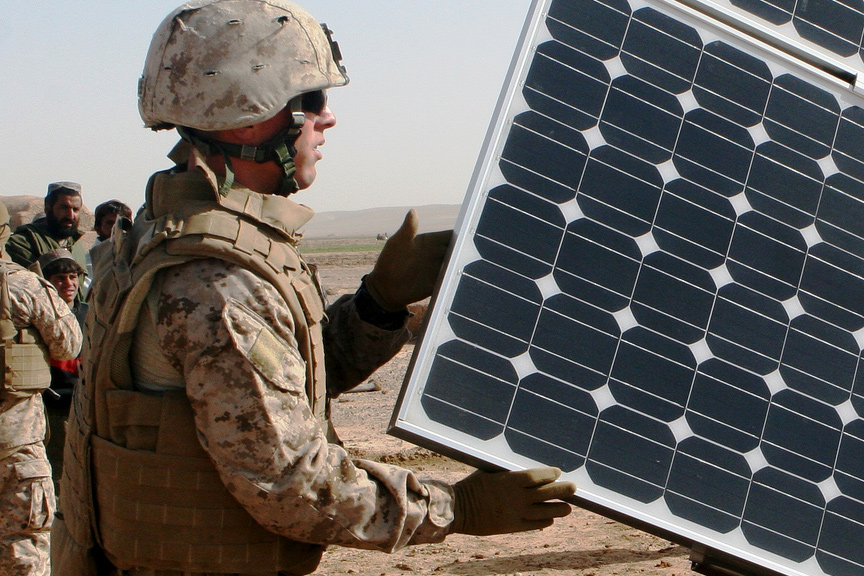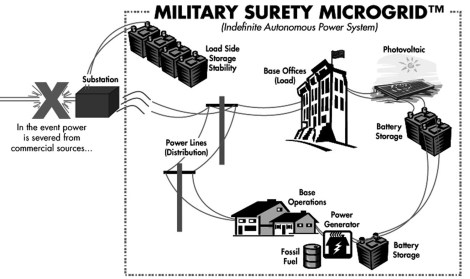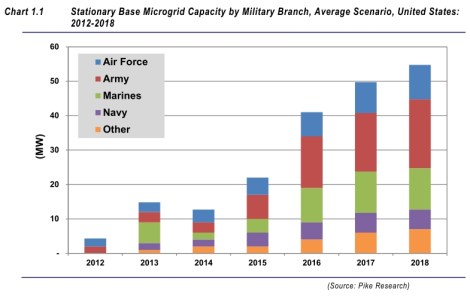The Department of Defense has bases in the U.S. and forward operating bases in theaters of war like Afghanistan. In both cases, providing reliable electricity, a strategic and tactical necessity for an increasingly wired military, is a challenge. One way the military is meeting that challenge is developing microgrids, which are way cooler than they sound.
The two types of DOD bases face the same challenge, but for different reasons. In Afghanistan, the diesel generators that provide electricity at bases are the top consumer of fuel on the battlefield. And it’s not just any fuel, it’s high-grade jet fuel, trucked into the country in caravans that cross treacherous, hostile territory and are frequently attacked. The “fully burdened cost” of that fuel — the cost of the fuel plus the costs of transporting and protecting it — can reach into the hundreds of dollars per gallon, especially at the smaller forward bases.
One way to reduce that fuel use is to generate more power on site, through distributed generation technologies like solar or waste-to-power plants. Another is to use that power more efficiently. And another is to network the base’s power sources and loads together into a microgrid that can be managed intelligently. For the bigger bases, it means they can be self-sustaining and not rely on primitive grids. For the smaller units up on the front lines, there are “mobile tactical microgrids,” which are small, modular systems that are easy to set up and disassemble, allowing a balance of connectivity and mobility.
Anyway, that’s the battlefield microgrid stuff, and it’s really cool. But I want to focus on the state-side “stationary” bases. As it happens, they are also plugged into a primitive grid — namely, the aging, shaky U.S. power grid. The military doesn’t trust it. It’s one thing if you’re at home and the lights flicker. It’s another if you’re piloting a drone strike by remote control and the lights flicker. So DOD is looking into microgrids for domestic bases too.
The idea is that the power grid serving a base could “island” itself from the larger grid, providing and controlling all its own power if necessary. It would do that through a combination of distributed generation, energy storage, energy efficiency, and smart power controls. If successful, even a total blackout of the larger grid would not affect power on the base. And though the primary purpose is security-related, it would also help DOD meet its clean-energy goals.
Here’s a representation of a military microgrid, from Sandia National Laboratory:
As it happens, Pike Research has a new report out on domestic military microgrids. Pike, the research arm of Navigant Consulting, releases a steady supply of fascinating reports that I can’t afford. (This one is $3,900.) Being subscribed to its newsletter is like water torture. The good news is, if you sign up you can at least see the executive summary for free.
Pike was able to identify around two dozen military facilities in the U.S. that are currently in the process of implementing microgrids. Most of them are using what Pike calls RDEG, or renewable distributed energy generation. Here’s what Pike projects for the next five years:
These are not huge numbers on an absolute basis, but they are interesting beyond just the megawatts involved.
There are other (non-military) microgrid projects — in a separate report, Pike identified more than 160 around the world (they expect up to 2,000 by 2015), used for everything from commercial applications to community deployments to off-grid projects serving small, remote villages. Most, almost 70 percent, are in North America and subject to democratic and economic pressures, which mean they’re on a short leash and subject to backlash if they fail or go over budget.
The U.S. military is one of the few institutions in the country with the capacity and the mandate to plan for the long term. That means it can bring a sustained focus to finding what works, tolerating some failures and high costs in the short term for strategic advantage down the road.
Consequently, we’re going to learn a ton from the military’s efforts. Right now, when we think about a microgrid that can island itself, we think either inclement circumstances (remote villages) or mission-critical activities (military bases). But as I wrote the other day, a truly resilient power grid would effectively be a patchwork of networked, overlapping microgrids. It makes sense for every region or even neighborhood to have some capacity to take care of itself should surrounding areas experience blackout or attack. It makes the whole system more fault-tolerant.
So we need to figure out microgrids. They are the key to power-grid resilience. What the military learns will find important application in the civilian world. Should be fun to watch.





